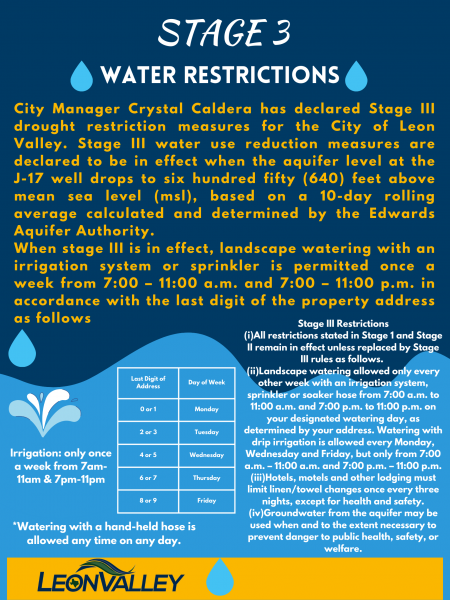Stage 3 Water Restrictions

Water Conservation Tips
What You Can Do:
Using a dishwasher can save you up to 24 gallons per load as long as you run your dishwasher every night. Using a dishwasher nightly instead of ten minutes of handwashing can save more than 100 gallons of water weekly. That totals more than 5,000 gallons of water annually. Modern, energy-efficient dishwashers save the most water (and energy), but even older models can be more efficient than handwashing. A modern dishwasher uses about four gallons of water compared to 27 gallons when washing the same dishes by hand. Older dishwasher models may use as much as fifteen gallons of water—still less than handwashing. If it is time to replace the appliance, check for water-conserving versions.
Water your lawn on the right day and at the right times. Most Texas cities restrict outdoor water use to one or two days a week during times of drought; and to certain times year-round. Save water and avoid fines by learning and following the city's schedule.
Catch the condensation from your AC unit and use it in your yard. Depending on how your air conditioner is programmed, it can produce gallons of water per day. Catch that water in a bucket and use it in your garden and on shrubs and trees. Install rain barrels at downspouts from gutters. Use this free water to water your garden!
Turn the water off when you brush your teeth. This simple step can save up to 8 gallons of water per day.
Fix leaky faucets. Leaky faucets can waste up to 7 gallons of water per day. To check for leaks at home, read your water meter and avoid using water for 2 hours. Read the meter again after this period. If the amount is different, you have a leak.
Fix running toilets, which waste a lot of water. Check your toilets frequently, as low flow toilet leaks are very quiet. Fix these leaks as soon as you find them. Check with the manufacturer of your toilet for the proper replacement "flapper" to ensure maximum efficiency.
Have your irrigation system inspected by a certified irrigator to make sure it is operating correctly, identify any problems, and help you set it to run more efficiently.
Try watering your lawn once or twice a week. Apply one to one and a half inches or water each time. Light, daily watering leaves too much water at or near the surface of the soil and does not reach all of the roots where it is needed. Deep watering allows moisture to reach the deepest roots. Allowing the soil to dry between watering will encourage the roots to go deeper to reach the needed moisture and nutrients.
Install faucet aerators and low-flow showerheads. These water saving devices are cheap and easy to install.
Install a high efficiency toilet. Toilets account for about 25% of water used in the home. Depending on the age of your toilet, you can save up to 5 gallons per flush by replacing older models.
Make water conservation a whole-family activity. Challenge your family members to think of new ways to save water and to be part of the solution!

